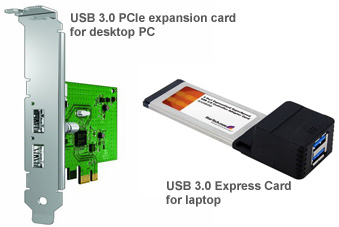
Like my tips? Click here to sign up for my free Daily Tech Tips Newsletter and you’ll never miss one!
Update: You can now add some blazing-fast USB 3.1 Type-C ports to your computer.
This post explains how.
Original post continues below…
In my opinion, no innovation in computer technology has had a greater positive impact on the average computer user than the Universal Serial Bus – commonly referred to simply as USB.
Back in the early days of computing most peripherals such as printers and modems were connected to a computer via an RS-232 serial interface and cable.
Trying to get these rudimentary RS-232 connections to work properly was a delicate mixture of science, art and prayer. The cable pin-outs varied depending upon whether you were connecting a Data Terminal Device (DTE) or a Data Communications Device (DCE). You also had to make sure the connectors were the right gender (male or female) and had the correct number of pins (either 9 or 25).
Finally, once the hardware connection was in place and correct, you had to make a number of software settings such as 8 data bits vs. 7 bits, baud rate (communication speed), and parity or no parity. It was a confusing mess, and if one setting was incorrect the communications between computer and peripheral would be garbled, rendering the device effectively useless.
The introduction of USB 1.0 in January 1998 changed all of that. Instead of having to pull all of your hair out while messing with cables, connectors and settings, you just plugged a standard cable into standard connectors and installed the software from a CD.
What’s more, the software installation itself was often automatically handled for you behind the scenes by the operating system. What a huge improvement!
Thanks to USB 1.0, a virtual computer novice could buy a new printer or other USB device and have it operating in minutes with nary a fret!
Better still, the maximum speed at which data could be transferred via a USB 1.0 connection was lightning fast compared to RS-232. And with the introduction of USB 2.0 in April 2000, that already blazing maximum speed was increased by a factor of 40. And now that USB 3.0 is here we can transfer data at a dazzling rate of 10 times the speed of USB 2.0!
But there is a problem…
Many computers in use today are still equipped with USB 2.0 ports, not the new USB 3.0. Even worse, some of the “new” computers being sold today still come equipped with USB 2.0 ports. This means that while that brand new USB 3.0 external hard drive you just bought will work just fine with your PC, it will only work at the much slower USB 2.0 speed.
But there is also good news. Depending on your computer, the chances are excellent that you can add two or more USB ports at a very reasonable cost (approximately $20 and up).
If your computer is a desktop…
If your PC is a desktop machine it will need an empty PCI Express (PCIe) slot into which you can plug in a USB 3.0 adapter card with either 2 or 4 USB 3.0 ports. You can easily find out if your computer has an empty PCIe slot by paying a visit to Google and searching for your computer’s brand and model number along with the word “specs”.
For example, I would type “Gateway DX4860-UB20P specs” into the search box without the quotes and press the Enter key. A number of sites would pop up in the search results listing the specifications for the PC in question, including the type and number of empty expansion slots.
If all else fails you can simply carry your PC into your nearest computer store and ask them to check on your behalf. Regardless of which way you go about it, if you’re able to determine that your computer has an empty PCIe slot you’re good to go!
You can purchase a 2 or 4 port USB 3.0 PCIe expansion card at most any electronics or computer store, but I suggest you save some money and choose a card from the excellent selection (#ad) at Amazon. You can easily install the card yourself or pay your neighborhood computer pro (usually the teenager down the street) to install it for you.
If your computer is a laptop…
If your PC happens to be a laptop you won’t be able to install an internal USB 3.0 card. Instead, you’ll need to plug in an external USB 3.0 Express Card adapter. Unfortunately, if your laptop is an older model with a PC Card connector instead of an Express Card connector you won’t be able to upgrade to USB 3.0.
You can purchase a USB 3.0 Express Card adapter at the same places mentioned earlier, including Amazon.
Installing it is a breeze – simply plug it into the slot located on the side of the laptop and install the drivers (Windows will most likely automatically install the drivers for you.)
Now that you have USB 3.0 at your fingertips, that new external USB 3.0 hard drive will work at mind-blowing speed!
If you found this post useful, would you mind helping me out by sharing it?
Just click one of the handy social media sharing buttons below. Thanks a bunch!